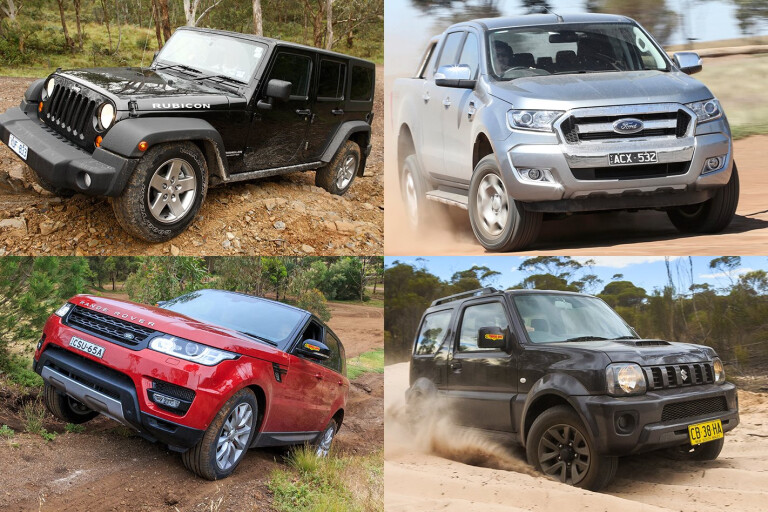
NEW 4x4s come in all shapes, sizes and prices.
Here at 4X4 Australia we’ve driven all of them a number of times, so this is our Dirty Dozen, our 12 best ‘new’ 4x4 buys, right down to the specifics of powertrain and spec level. There are eight turbo-diesels – three of which have two turbos apiece – and four petrols. There are no manuals among our preferred variants, but four of them have manual options. The remaining eight are auto-only – a sign of the times.
1. SUZUKI JIMNY AUTOMATIC
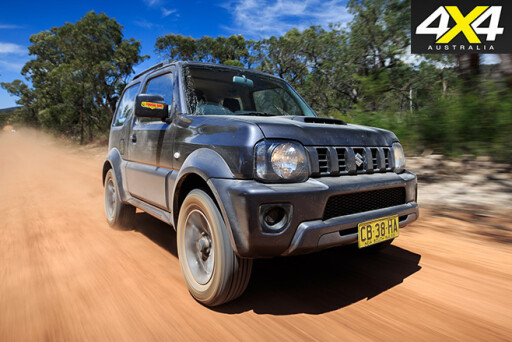 The Jimny Sierra traces a direct lineage back to the original 4x4 created by Suzuki nearly 50 years ago.
The Jimny Sierra traces a direct lineage back to the original 4x4 created by Suzuki nearly 50 years ago.
The Jimny is an old-school-tough 4x4. Old-school in this case means a separate chassis and live axles back and front, just like a Toyota 70 Series, a GU Patrol, a Land Rover Defender or a Jeep Wrangler.
The Jimny comes with either a five-speed manual or a four-speed automatic transmission, but in one trim level. For a number of reasons we prefer the auto, but there’s a case to be made for the manual (the $2000 discount, for one).
With either manual or auto you get a 1.3-litre four-cylinder petrol engine that claims a very modest 62.5kW at a heady 6000rpm and 110Nm that doesn’t come onstream until 4100rpm. The Jimny’s engine features double overhead cams, four valves per cylinder and variable valve timing on the inlet side, and it was introduced to the Jimny in 2005.
Offsetting the low power and torque numbers is a kerb weight of just 1075kg, so in terms of power-to-weight that’s the same as having a 2150kg 4x4 with 125kW, which is not unusual. However, the engine still needs plenty of revs to give its best, which doesn’t help the otherwise good fuel economy.
 The manual is the pick for on-road driving, but the auto comes into its own off-road – particularly for rock climbing, given the gearing multiplier effect of the torque converter helps overcome the modest crawl ratio and the lack of engine torque at low engine speeds. The auto also works better in sand and has the advantage of longer highway legs.
The manual is the pick for on-road driving, but the auto comes into its own off-road – particularly for rock climbing, given the gearing multiplier effect of the torque converter helps overcome the modest crawl ratio and the lack of engine torque at low engine speeds. The auto also works better in sand and has the advantage of longer highway legs.
The Jimny ticks all the basic boxes when off-road: light weight, decent clearance, generous wheel travel (thanks to its front and rear live axles), steep approach and departure angles, a tight turning circle and good visibility. The newly fitted electronic traction control (from 2015-on) helps off-road and is a welcome addition.
The Jimny’s light weight makes for a fun on-road drive, but its relatively narrow track and tall stance are limiting factors when pushing on. Surprisingly, for a very light 4x4 with front and rear live axles, ride quality and general stability are both better than expected.
The Jimny’s big limitation is its size. It seats just four, and if you’re going away for a bush weekend there’s really only room for two people plus luggage. The small 40-litre fuel tank and 95RON fuel requirement are also limitations you need to be aware of.
Still, the Jimny is a fun-filled, highly practical, down-to-earth 4x4 that’s great value for the money. Plus it’s supported by a wide range of aftermarket enhancements.
SPECS
Price: $22,990
Engine: 1.3-litre 4-cyl petrol
Power: 62.5kW
Torque: 110Nm
Gearbox: four-speed automatic
4x4 system:dual-range part-time
Front suspension: live axle/coil springs
Rear suspension: live axle/coil springs
Kerb weight: 1075kg
GVM: 1420kg
Towing capacity: 1300kg
Fuel tank capacity: 40 litresADR fuel claim: 7.4L/100km
2. VOLKSWAGEN AMAROK TDI420 CORE
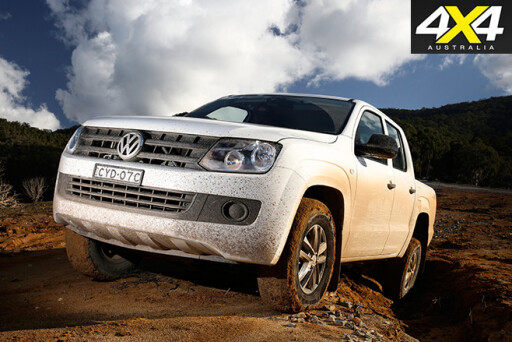 The Amarok’s eight-speed breaks all the rules, but it’s brilliantly clever and capable. And in Core spec, it’s dirt-cheap.
The Amarok’s eight-speed breaks all the rules, but it’s brilliantly clever and capable. And in Core spec, it’s dirt-cheap.
JUST in case you weren’t aware, the Volkswagen Amarok comes with two different gearboxes mated to their own 4x4 system. The six-speed manual comes with conventional dual-range, part-time 4x4. On paper this traditional 4x4 system looks like the pick, given the automatic doesn’t have a two-speed transfer case. But that’s not the case – far from it, in fact.
Importantly, the low first gear of the eight-speed auto and the torque converter’s high stall ratio help counter the lack of low-range gearing. The 4x4 system mated to the auto transmission also has the benefit of a self-proportioning and self-locking centre differential, similar to what you’ll find in a Land Rover Discovery or Range Rover, which delivers off-road benefits as well as the on-road functionality of full-time 4x4.
The Amarok auto’s 4x4 system is so clever you can go from cruising down the freeway at any speed straight onto a steep and gnarly off-road climb without touching a lever or a single button. And the Amarok auto will get the job done as well as, if not better than, any other ute in its class. It’s simply astonishing.
If you do get into trouble the Amarok has a driver-switched rear locker to call upon and, unlike the rear locker on the HiLux and the Triton, activating the Amarok’s rear locker doesn’t cancel the electronic traction control, so it’s another win-win.
 The Amarok has a smallish 2.0-litre engine, but thanks to its bi-turbo arrangement it still offers power and torque that’s competitive in its class. The engine stands out for its willingness to rev harder than those of its competitors, and it’s also strong off idle. That’s the benefit of having one smaller and one larger turbo.
The Amarok has a smallish 2.0-litre engine, but thanks to its bi-turbo arrangement it still offers power and torque that’s competitive in its class. The engine stands out for its willingness to rev harder than those of its competitors, and it’s also strong off idle. That’s the benefit of having one smaller and one larger turbo.
By modern diesel standards the Amarok’s engine is smooth, quiet and refined, while the eight-speed auto is sweet in terms of shift quality, shift speed and shift timing. The Amarok’s chassis maintains the same polished performance as the engine and offers precise steering and surprisingly sporty handing.
The Amarok has a big, spacious and comfortable cabin with supportive front seats, tilt-and-reach steering wheel adjustment for the driver, and the widest back seat in its class. The Core spec is basic yet functional, but the deletion of the 12-volt outlet from the dash-top and another from the tub (both standard on other Amarok models) are notable negatives. The softer-riding ‘Comfort’ rear leaf springs (optional elsewhere on Amarok 4x4s) also aren’t available on the Core.
At the time of writing the automatic was a ‘special’ no-cost option, providing a saving of $3000. That’s almost too good to ignore.
SPECS
Price: $45,990
Engine: 2.0-litre 4-cyl bi-turbo-diesel
Power: 132kW
Torque: 420Nm
Gearbox: eight-speed automatic
4x4 system: single-range full-time
Front suspension: independent/coil springs
Rear suspension: live axle/leaf springs
Kerb weight: 1989kg
GVM: 3040kg
Towing capacity: 3000kg
Fuel tank capacity: 80 litres
ADR fuel claim: 8.3L/100km
3. TOYOTA FJ CRUISER
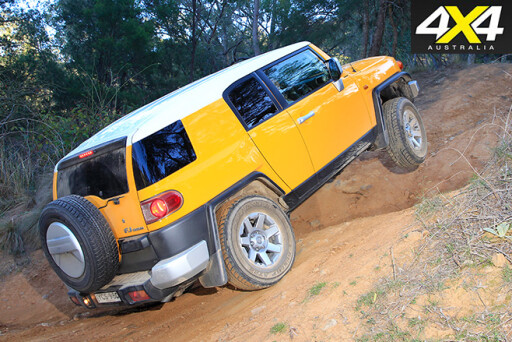 Much more than a Prado in fancy dress, Toyota’s FJ Cruiser offers seriously good value for money.
Much more than a Prado in fancy dress, Toyota’s FJ Cruiser offers seriously good value for money.
YOU better get in quick if you want an FJ Cruiser, as production of Australian-delivered Cruisers will cease in August. The FJ will still be around in local showrooms for a while after that, but for how long is difficult to say.
The FJ is essentially a petrol Prado but with part-time 4x4 and a shortened wheelbase. It also only comes with a five-speed automatic. The lack of a diesel engine and, to a lesser extent, a manual gearbox has no doubt limited its sales, but that doesn’t mean it’s not a good thing. When it arrived in Australia in 2011 it took out our annual 4X4 Of The Year award against very stiff competition, and it’s still one of our favourites here at 4X4 Australia.
The FJ’s 4.0-litre V6, complete with variable valve timing on both cams, claims 200kW and 380Nm in typically Toyota-like ‘soft’ tune, where power spread, not peak power, is the name of the game.
The FJ is around 200kg lighter than a petrol-powered Prado, so outright performance and mid-range flexibility are noticeably better. The five-speed gearbox works well with the engine and has a gated shift for ‘manual’ gear selection, rather than the tip-shift of the current Prado.
 Perhaps the biggest surprise of all is the FJ’s modest thirst, no doubt helped by its reduced weight and the engine’s soft tune. Combined with the 159-litre fuel capacity, this makes for a decent touring range.
Perhaps the biggest surprise of all is the FJ’s modest thirst, no doubt helped by its reduced weight and the engine’s soft tune. Combined with the 159-litre fuel capacity, this makes for a decent touring range.
The reduced weight and better mass centralisation, thanks to little rear overhang, also makes for surprisingly good on-road dynamics, despite the soft suspension and some unsettling from the live rear axle on bumpier roads.
As good as the FJ is on-road, it comes into its own off-road thanks to its supple long-travel suspension and superior ground clearance and approach, departure and ramp-over angles (compared to a Prado). In fact, it has the best approach and departure angles of any Toyota 4x4.
The FJ comes with a driver-operated rear diff lock and, while engaging this negates the traction control on both axles, the driver can reinstate off-road-specific traction control (A-TRC) across the front axle even when the rear diff is locked, which is a major bonus when the going gets tough.
Given the FJ misses out on the third-row seating of the Prado – and access to the rear seat is somewhat restricted – it’s not really a family 4x4. However, the cabin is surprisingly comfortable and plenty roomy for a two-person getaway. Add in the fact the FJ is well supported by the aftermarket and you have a robust, practical, capable and Toyota-reliable enthusiast’s 4x4.
SPECS
Price: $46,990
Engine: 4.0-litre V6 petrol
Power: 200kW
Torque: 380Nm
Gearbox: five-speed automatic
4X4 system: dual-range part-time
Front suspension: independent/coil springs
Rear suspension: live axle/coil springs
Kerb weight: 2000kg
GVM: 2510kg
Towing capacity: 2250kg
Fuel tank capacity: 159 litres
ADR fuel claim: 11.4L/100km
4. MITSUBISHI TRITON EXCEED
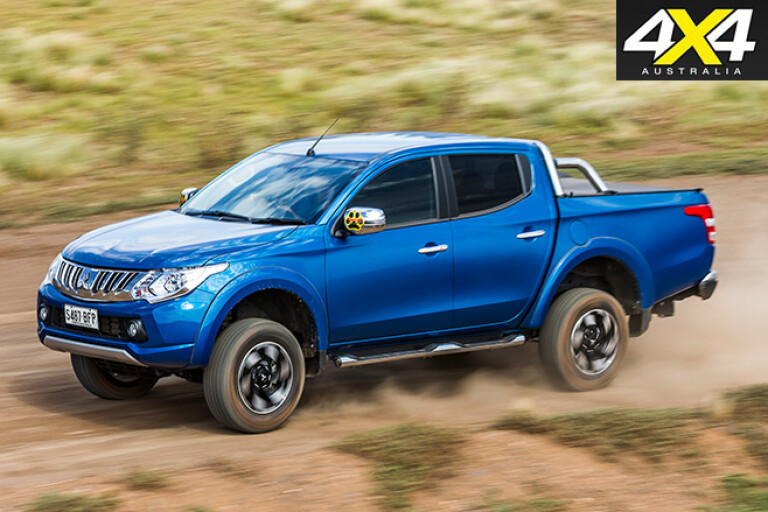
Mitsubishi’s Triton is Australia’s third best-selling ute for good reason – it’s exceptional value for your hard-earned.
IN creating the fifth-generation (MQ) Triton, released in early 2015, Mitsubishi didn’t try to build a big ute like the Ford Ranger, Volkswagen Amarok, Holden Colorado, or any other new-generation ute released a few years earlier. Instead it took the previous-generation Triton, pulled it apart and put it back together with a whole raft of new or revised parts.
The most notable of these are an all-new 2.4-litre engine, new six-speed manual, heavily revised suspension and a slightly bigger cabin. The result is a smaller ute than the Ranger (and friends), with a lower GVM and less towing capacity. The Triton’s relatively short wheelbase also means just about the entire tray is behind the rear axle, which isn’t ideal for carrying heavier loads.
However, the Triton has a couple of big aces up its sleeve in the form of extremely sharp pricing and selectable full-time 4x4 in the mid- and top-spec models – the Volkswagen Amarok auto is the other mainstream ute to offer full-time 4x4.
The Triton’s value for money comes to the fore in the top-spec Exceed model, our pick of the range. For the price of most competitors’ mid-spec manual dual-cabs you get a five-speed auto as standard, Super Select selectable full-time 4x4 system, a rear locker, keyless entry, push-button start, leather seats (with electric adjust for the driver), sat-nav via a seven-inch touchscreen, and a reversing camera. You also get auto wipers and headlights, paddle shifters for the five-speed auto, dual-zone climate, daytime running lamps, sidesteps, and all the safety stuff that’s standard across the rest of the range. Against competitors’ top-spec dual-cabs you’ll save between $6K and $12K.
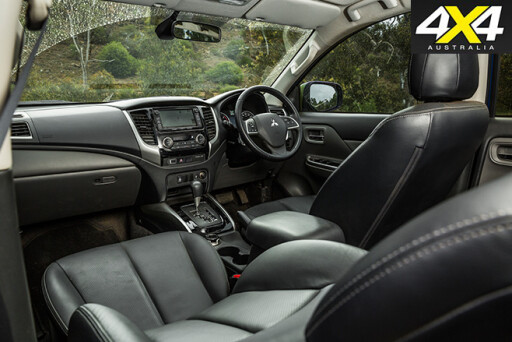 The Triton’s new 2.4-litre donk is quite revvy given its maximum torque isn’t available until 2500rpm, but the auto effectively masks any sense there’s insufficient power at low revs. The engine is relatively smooth, quiet and refined. By class standards the Triton also offers competitive performance thanks in part to its light weight.
The Triton’s new 2.4-litre donk is quite revvy given its maximum torque isn’t available until 2500rpm, but the auto effectively masks any sense there’s insufficient power at low revs. The engine is relatively smooth, quiet and refined. By class standards the Triton also offers competitive performance thanks in part to its light weight.
On the move the Triton has light and sporty handling compared to most in its class, and it benefits from the all-roads functionality of selectable full-time 4x4. With Super Select the driver can also select rear-wheel drive, which stands this system apart from conventional full-time 4x4 systems.
The Exceed isn’t class-leading when off-road, but its rear locker puts it in front of lower-spec Tritons. The relatively short wheelbase helps in tight situations and the Super Select means you can have 4x4 drive without locking the centre diff, which can be very useful at times.
The Exceed’s cabin is nicely detailed and the driver has the benefit of tilt-and-reach steering wheel adjustment, which isn’t standard on many competitor utes. All up, the Exceed is great value.
SPECS
Price: $47,990
Engine: 2.4-litre 4-cyl turbo-diesel
Max power: 133kW
Torque: 430Nm
Gearbox: five-speed automatic
4x4 system: dual-range full-time (+2WD)
Front suspension: independent/coil springs
Rear suspension: live axle/leaf springs
Kerb weight: 1965kg
GVM: 2900kg
Towing capacity: 3100kg
Fuel tank capacity: 75 litres
ADR fuel claim: 7.6L/100km
5. JEEP WRANGLER RUBICON
The Wrangler is the most off-road-capable Jeep, and the Rubicon is the most off-road-capable Wrangler.
WALK into a Jeep showroom and you’ll see a wide variety of different vehicles all sporting a Jeep badge. Trouble is: appearances are deceptive. Of all the vehicles currently sold as Jeeps, only the Wrangler can be considered a ‘proper’ Jeep.
What’s important here is that the current-generation Wrangler dates back nearly 10 years and is nearing the end of its production cycle. What the next generation Wrangler will bring to the party is yet to be confirmed. Could this be the last ‘proper’ Jeep? Only time will tell.
For the off-road enthusiast the standout in the Wrangler range is the Rubicon, which has always been petrol-only. But unlike times past it’s now only available as a four-door and with an automatic gearbox.
The Rubicon is mechanically different from the ‘bread and butter’ Wranglers thanks to lower diff and transfer case ratios, so even with the five-speed automatic you have an impressively low 53.5:1 crawl ratio. Unlike other Wranglers the Rubicon also comes with front and rear driver-switched diff locks and a front sway bar that can be disconnected (via a dashboard switch) to maximise the front wheel travel.
![]() The Rubicon’s front and rear coil-sprung live axles underpin its impressive off-road ability. They provide generous travel at both ends and, combined with the electronic traction control and extra-low gearing, will get you most places. If things get tough then disconnecting the front sway bar gives you even more front-wheel travel, and if you still need more help you have the front and rear lockers to call upon. Off-road kit in a stock 4x4 simply doesn’t come any better.
The Rubicon’s front and rear coil-sprung live axles underpin its impressive off-road ability. They provide generous travel at both ends and, combined with the electronic traction control and extra-low gearing, will get you most places. If things get tough then disconnecting the front sway bar gives you even more front-wheel travel, and if you still need more help you have the front and rear lockers to call upon. Off-road kit in a stock 4x4 simply doesn’t come any better.
What eventually stops the Rubicon is its ground clearance, but this is easily addressed via a bigger wheel/tyre package or a lift kit, given the live-axle design.
On the road the 3.6-litre V6 is smooth, willing and flexible; rapid even at high engine speeds. It’s all helped by a slick five-speed automatic with ‘manual’ shifting.
The Rubicon does its best work off-road, but it isn’t too shabby on-road provided the tarmac is reasonably smooth. At higher speeds on bumpy roads it tends to bump steer, but this is something you learn to live with.
The Rubicon’s interior is nicely finished and generally comfortable, but shorter drivers will find the vision over the dash isn’t as good as it could be. Bonus points for the removable panels in the hardtop and the fact the hardtop can be removed altogether and replaced with a fold-down soft-top. And if you really want the open-air feel, you can always remove the doors. This alone makes the Rubicon (and any Wrangler for that matter) unique in today’s 4x4 market.
SPECS
Price: $53,990
Engine: 3.6-litre V6 petrol
Power: 209kW
Torque: 347Nm
Gearbox: five-speed automatic
4x4 system: dual-range part-time
Front suspension: live axle/coil springs
Rear suspension: live axle/coil springs
Kerb weight: 2073kg
GVM: 2540kg
Towing capacity: 2000kg
Fuel tank capacity: 85.2 litres
ADR fuel claim: 11.9L/100km
6. FORD RANGER XLT AUTOMATIC
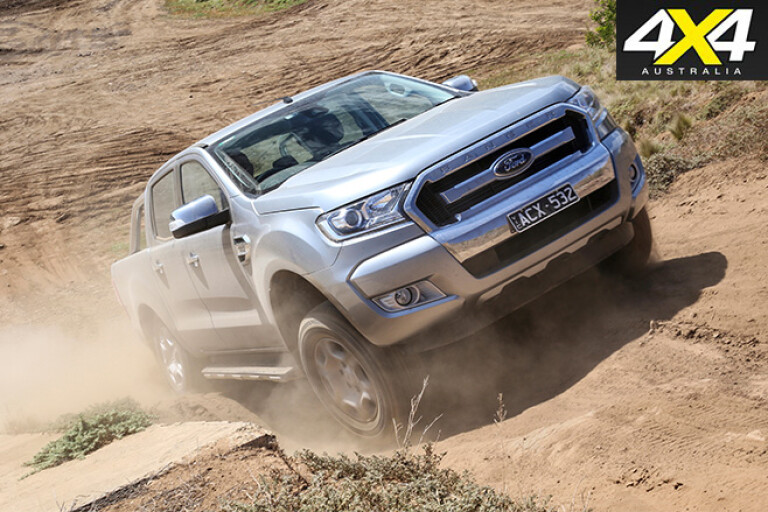
The Ford Ranger is Australia’s second-best-selling 4x4, and it’s closing in on the ever-popular Hilux.
THE Ford Ranger PX first appeared in late 2011, and despite carrying over the name of its predecessor it was in fact an all-new ute. Most significantly, its design and development was headquartered here in Australia.
The Ranger underwent a major facelift in mid-2015, with revised front-end styling and interior changes including a new dashboard and larger multi-function touchscreen. More significant were the mechanical upgrades, including a more efficient turbo for faster spool-up, new fuel injectors, changes to the cylinder head, and various other measures to improve engine performance and NVH.
Electric power steering also replaced the previous hydraulically assisted unit, while the electronic control of the 4x4 system was significantly enhanced. For example, when you engage the rear locker the electronic traction control remains active on the front axle, whereas before it was cancelled both front and rear.
Interestingly, none of these changes were made to the Mazda BT-50. Initially the
BT-50 was a near identical twin to the Ford Ranger, but it’s now notably different and
not as good.
Ford also successfully addressed the crook shift action of the six-speed manual with the 2015 upgrade, but our choice is still the six-speed automatic. For spec level we would then go for the XLT, as it brings sat-nav, a bigger eight-inch touchscreen, dual-zone climate, a centre-console cooler, rear parking sensors, auto wipers, sports bar and a 12-volt outlet in the tub.
 The most notable thing about the Ranger is that it’s a big ute in just about every sense. Along with the BT-50 it has the longest wheelbase, the longest cabin and the biggest engine: a 3.2-litre five-cylinder turbo-diesel where smaller four-cylinder turbo-diesels are the class norm. It also has a class-leading GVM and tow rating.
The most notable thing about the Ranger is that it’s a big ute in just about every sense. Along with the BT-50 it has the longest wheelbase, the longest cabin and the biggest engine: a 3.2-litre five-cylinder turbo-diesel where smaller four-cylinder turbo-diesels are the class norm. It also has a class-leading GVM and tow rating.
On the road the engine delivers effortless performance without having to rev hard, and it has a particularly relaxed and smooth gait at highway speeds. The engine mates nicely to the six-speed auto.
By ute standards the Ranger handles and rides well on-road, while the new electric power steering makes for much easier low-speed manoeuvring both in car parks and in tight off-road situations.
The Ranger is right up there at the pointy end of the field when off-road, thanks in part to its recent revisions. If you want a big ute that can do it all, it’s hard to go past the Ranger XLT auto.
SPECS
Price: $56,390
Engine: 3.2-litre 5-cyl turbo-diesel
Power: 147kW
Torque: 470Nm
Gearbox: six-speed automatic
4x4 system: dual-range part-time
Front suspension: independent/coil springs
Rear suspension: live axle/leaf springs
Kerb weight: 2159kg
GVM: 3200kg
Towing capacity: 3500kg
Fuel tank capacity: 80 litres
ADR fuel claim: 9.2L/100km
7. FORD EVEREST TREND
 The current 4X4OTY makes this list off the back of great value for money and a broad spectrum of capabilities.
The current 4X4OTY makes this list off the back of great value for money and a broad spectrum of capabilities.
JUST in case you didn’t know, the Everest is essentially a wagon version of Ford’s highly successful Australian-developed Ranger ute. Aside from the obvious body change, there are coil springs in place of leaf springs for the rear axle, disc brakes instead of drums at the rear, and an active full-time 4x4 system rather than the Ranger’s part-time system. The wheelbase has also been reduced from the Ranger’s extraordinarily long 3220mm.
Our pick of the three-model, all-automatic range is the mid-spec Trend, which is the 4X4 Of The Year winner.
For an extra $6000 over the still well-equipped, base-spec Ambiente, the Trend gains adaptive cruise control, forward-crash mitigation, lane-keeping assistance, projector headlights with auto high-beam on/off, daytime running lamps, auto wipers, front parking sensors and a power tailgate. You also get a premium audio system, a much bigger touchscreen (eight-inch instead of 4.2) and sat-nav as a $600 option, which is not available on the base spec at all. That’s plenty of kit for just $6K.
Mind you, you also get 18s instead of 17s. The Everest runs Prado tyre spec in 17- and 18-inch sizes, so tyre availability is good. Meanwhile, the jump to the top-spec Titanium is a significant $16K, but for that you get 20s, which you definitely don’t want if you are planning to take your Everest to the bush.
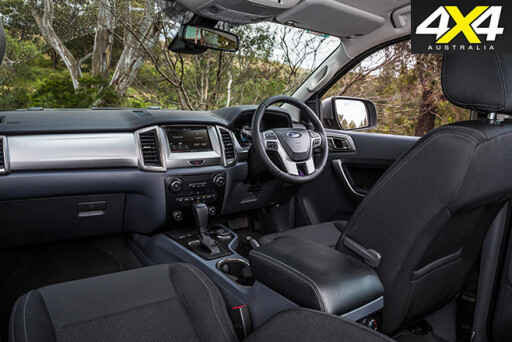 The Everest shares the 2015 face-lifted Ranger’s 3.2-litre inline five-cylinder diesel engine, but with AdBlue pollutant-reducing technology and a touch less power. The five-cylinder design is a little lumpy at idle but smooths out nicely at highway speeds, where it has a relaxed gait quite different to competitor four-cylinder designs. It’s strong at low revs and doesn’t need to be revved hard to give its best.
The Everest shares the 2015 face-lifted Ranger’s 3.2-litre inline five-cylinder diesel engine, but with AdBlue pollutant-reducing technology and a touch less power. The five-cylinder design is a little lumpy at idle but smooths out nicely at highway speeds, where it has a relaxed gait quite different to competitor four-cylinder designs. It’s strong at low revs and doesn’t need to be revved hard to give its best.
Despite the Everest’s hefty weight and live-axle rear suspension it feels quite sporty through corners, and the electric power steering, which is exceptionally light at parking speeds and when off-road, firms up nicely at higher road speeds. Active full-time 4x4 is also a major benefit on all-road, all-weather driving.
The Everest could do with a tad more clearance and wheel travel when driving off-road, but it does have the benefit of a driver-switched rear locker, which doesn’t cancel the traction control across the front axle when engaged.
The Everest offers a spacious and comfortable seven-seat cabin thanks in part to a wheelbase – while shortened from the Ranger – that matches a Land Cruiser 200. The amount of luggage space behind the rear seats when the third row is deployed is impressive. Not so good is the vision from the driver’s seat or the lack of tilt-and-reach steering wheel adjustment.
SPECS
Price: $60,990
Engine: 3.2-litre 5-cyl turbo-diesel
Power: 143kW
Torque: 470Nm
Gearbox: six-speed automatic
4x4 system: dual-range full-time
Front suspension: independent/coil springs
Rear suspension: live axle/coil springs
Kerb weight: 2407kg
GVM: 3100kg
Towing capacity: 3000kg
Fuel tank capacity: 80 litres
ADR fuel claim: 8.5L/100km
8. LAND ROVER DISCOVERY TDV6
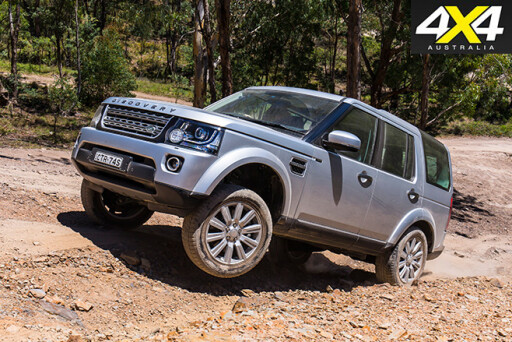 Nearing the end of its life, Land Rover’s Discovery remains the benchmark in so many ways.
Nearing the end of its life, Land Rover’s Discovery remains the benchmark in so many ways.
LIKE a number of vehicles in the Dirty Dozen, the Discovery is a former 4X4 Of The Year winner. In fact, the Discovery has been a habitual 4X4OTY winner, the last time when the TDV6 you see here was released in 2012.
Back then it was called Discovery 4 – now it’s just called Discovery to distinguish it from the Discovery Sport, effectively a third-generation Freelander.
Either way, the TDV6 is the latest iteration of a vehicle line that goes back some 13 years to the original Discovery 3 (the 4 being just a development of the D3’s basic platform).
The TDV6 is the entry model in the Discovery line-up and is comfortably the pick of the range for a number of reasons. First up, just about all the features that don’t come standard with the TDV6 can be added as options, with only a handful of high-end entertainment options unavailable, including rear DVD and digital TV.
Most importantly you can add leather, third-row seats, sat-nav and a rear auto-locking differential, among other options – most of which are standard on the more expensive SDV6.
The SDV6 also comes with a more powerful version of the Discovery’s 3.0-litre bi-turbo-diesel V6, which offers 183kW and 600Nm versus 155kW and 520Nm for the TDV6.
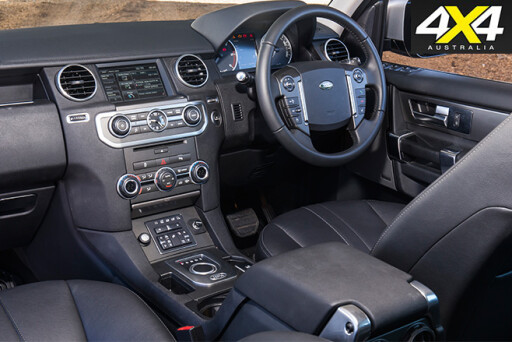 But here’s the rub: the SDV6 and the TDV6 engines are mechanically identical and only differ in tuning software. A Land Rover dealer isn’t about to do the tune-up for you, and they’ll probably say it will void your warranty. However, it can be done – and it’s not hard. Plus, you’re not tuning the engine beyond what it’s designed for – something that’s not the case with most diesel engine upgrades. Either way, the low-tune engine mates beautifully to the slick ZF eight-speed gearbox to produce a relaxed, adequately powerful and refined powertrain.
But here’s the rub: the SDV6 and the TDV6 engines are mechanically identical and only differ in tuning software. A Land Rover dealer isn’t about to do the tune-up for you, and they’ll probably say it will void your warranty. However, it can be done – and it’s not hard. Plus, you’re not tuning the engine beyond what it’s designed for – something that’s not the case with most diesel engine upgrades. Either way, the low-tune engine mates beautifully to the slick ZF eight-speed gearbox to produce a relaxed, adequately powerful and refined powertrain.
Unlike the Prado and 200 Series, the Discovery has height-adjustable air spring suspension, so it’s relatively low on-road ride height doesn’t compromise off-road clearance and vice versa. In fact, the Discovery works beautifully both on- and off-road. However, the rear-locker option is a must for anyone who wants to fully utilise their Discovery’s off-road potential.
Complementing the Discovery’s broad spectrum of on- and off-road capabilities is its big, space-efficient cabin that remains a standard-setter in functionality.
As ever, the Discovery’s small fuel capacity and wheel and tyre spec are practical shortcomings. The former can be addressed relatively easily, the latter not so. But still, the Discovery is a great 4x4. Let’s hope its replacement due next year is at least as good.
SPECS
Price: $69,630
Engine: 3.0-litre V6 bi-turbo-diesel
Power: 155kW
Torque: 520Nm
Gearbox: eight-speed automatic
4x4 system: dual-range full-time
Front suspension: independent/air springs
Rear suspension: independent/air springs
Kerb weight: 2558kg
GVM: 3240kg
Towing capacity: 3500kg
Fuel tank capacity: 82.3 litres
ADR fuel claim: 8.8L/100km
9. NISSAN PATROL Y62 Ti
 Thanks to a huge price cut last year, Nissan’s unloved V8 Patrol now looks like good shopping.
Thanks to a huge price cut last year, Nissan’s unloved V8 Patrol now looks like good shopping.
LAST year Nissan slashed nearly $30K off the top-spec Ti-L model in its Y62 Patrol V8 range, which had been on sale for a few years and not impacted the sales charts. At the same time the base-spec ST-L was dropped and the price of the mid-spec Ti, effectively now the new base model, was cut $24K to $69,990. That puts the Ti $23K cheaper than a petrol 200 VX and $28K cheaper than a diesel 200 VX (the VX being the closest 200 Series spec-level to the Patrol Ti).
Put another way, $69,990 for the Patrol Ti makes it $3K to $4K cheaper than a petrol or diesel Prado VX, which is astonishing given what the Y62 offers.
First up, the Y62 is a big 4x4. Drive it back-to-back with a 200 and the Y62 almost feels like a bigger class of vehicle. The second-row seat is especially generous compared to the 200 and its luggage space is also notably larger.
The Y62 offers a 5.6-litre V8 that makes the 4.6-litre (petrol) V8 in the 200 seem a bit limp-wristed. The numbers tell part of the story (298kW/560Nm versus 228kW/439Nm), but the other part is that Nissan’s V8 comes from an engine family with serious motorsport credentials. This includes the V8 used by Nissan in its local V8 Supercars and the V8 that dominates the LMP2 class in international sports car endurance racing (Le Mans 24 Hour, etc).
The Y62’s 298kW makes it one very potent 4x4 on-road, and for those who like V8s it’s a much more vocal engine than the 200’s rather subdued 4.6.
 To help keep all this performance and a fair bit of weight (2800kg) in check, the Y62 has something very special in the suspension department: Hydraulic Body Motion Control (HBMC). HBMC is a far more sophisticated suspension system than what’s under a 200, even one with KDSS.
To help keep all this performance and a fair bit of weight (2800kg) in check, the Y62 has something very special in the suspension department: Hydraulic Body Motion Control (HBMC). HBMC is a far more sophisticated suspension system than what’s under a 200, even one with KDSS.
HBMC is a fully independent coil-spring system with active dampers that limit on-road bodyroll but also maximise off-road wheel travel, and all without mechanical sway bars. The system works brilliantly. The Y62 corners much flatter than a 200 on-road yet can still keep up with a 200 off-road, even if it needs more under-engine protection for very rocky going.
At $69,990 the Ti is very well-equipped, but the big downside is that the Y62 is thirsty. The always-conservative official ADR fuel number, 14.4L/100km in this case, probably tells you all you need to know. On our last test we averaged 17.7L/100km. The time before that, with more low-range work, it registered 21.3L/100km.
The upside is that there’s a 140-litre tank, so the range is still okay. And with the $23K to $28K saving over a 200 VX, that’s a lot of free fuel before you hit price parity.
SPECS
Price: $69,990
Engine: 5.6-litre V8 petrol
Power: 298kW
Torque: 560Nm
Gearbox: seven-speed automatic
4x4 system: dual-range on-demand
Front suspension: independent/coil springs
Rear suspension: independent/coil springs
Kerb weight: 2800kg
GVM: 3450kg
Towing capacity: 3500kg
Fuel tank capacity: 140 litres
ADR fuel claim: 14.4L/100km
10. TOYOTA PRADO VX
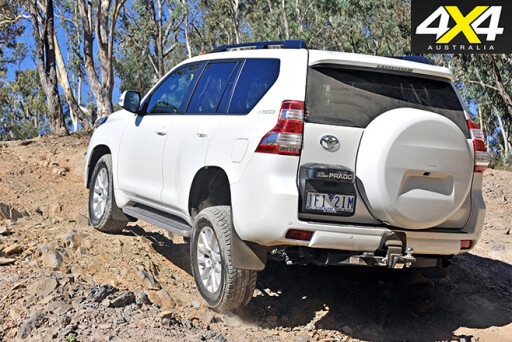 The Prado is Australia’s best-selling 4x4 wagon for good reason. Many good reasons in fact.
The Prado is Australia’s best-selling 4x4 wagon for good reason. Many good reasons in fact.
OTHER than a short period back in 2014 when Jeep Grand Cherokee sales were peaking, the Prado has long been Australia’s best-selling 4x4 wagon. Before the rise in popularity of 4x4 utes it was Australia’s best-selling 4x4 overall.
The Prado is now the default Land Cruiser, given the 200’s ritzy pricing (and possibly larger size) is not to everyone’s liking. In many ways, not least in size, the Prado is today’s 80 or 100 Series – in their day the most popular 4x4s.
The Prado is a proper Land Cruiser, a 150 Series to be precise. That’s something often not acknowledged and even denied – just because it’s smaller than a 200 doesn’t mean it’s a lesser vehicle.
The big question is: What Prado from the nine-model range is the pick? Discounting the three petrol models, there are two ways to go with the diesel. If you’re planning on building a bush tourer then the five-seat GX, probably in manual, is the only way to go. However, if you want more of a general-duties, day-to-day family 4x4, then we think it’s worth bypassing the popular GXL auto and going for a VX.
Trouble is the VX is an additional $12K over and above the $61,990 GXL auto, which seems like a lot until you drive the two back-to-back. The VX offers far sportier and flatter on-road handing and better off-road performance, thanks to longer and more supple wheel travel.
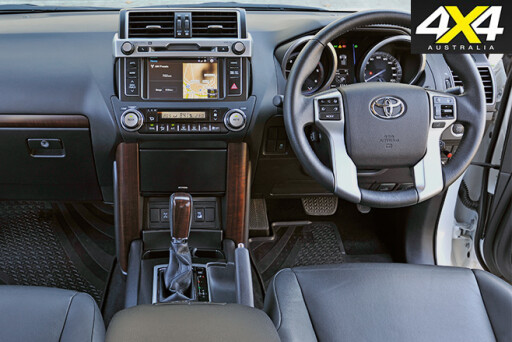 The difference is the VX’s Kinetic Dynamic Suspension System (KDSS), a brilliantly simple hydro-mechanical system that automatically adjusts the tension on the suspension’s sway bars. KDSS is standard on the VX but unfortunately unavailable on the GXL, even as an option.
The difference is the VX’s Kinetic Dynamic Suspension System (KDSS), a brilliantly simple hydro-mechanical system that automatically adjusts the tension on the suspension’s sway bars. KDSS is standard on the VX but unfortunately unavailable on the GXL, even as an option.
The VX also ups the ante with leather, heated front- and second-row seats, electric seat and steering wheel adjustment, power-fold third-row seating, auto headlights and wipers, a 17-speaker premium audio system and front parking sensors. You also get 18s instead of 17s, but the tyre spec is still very bush-friendly.
Compared to the previous 3.0-litre diesel, the new 2.8-litre diesel is noticeably quieter, smoother and more flexible, but it doesn’t offer a significant jump in outright performance.
As ever, the Prado cabin is comfortable, roomy and nicely detailed, especially at the VX spec. Practical features, such as the 150-litre fuel tank, are all supported by an extensive dealer network. Plus there’s a vast array of aftermarket enhancements available.
SPECS
Price: $73,990
Engine: 2.8-litre 4-cyl turbo-diesel
Power: 130kW
Torque: 450Nm
Gearbox: six-speed automatic
4x4 system: dual-range part-time
Front suspension: independent/coil springs
Rear suspension: live axle/coil springs
Kerb weight: 2400kg (approx.)
GVM: 2900kg
Towing capacity: 2500kg
Fuel tank capacity: 150 litres
ADR fuel claim: 8.4L/100km
11. TOYOTA LAND CRUISER 200 GX
 The GX is not only the least-expensive 200 Series, it’s the most bush-ready.
The GX is not only the least-expensive 200 Series, it’s the most bush-ready.
WHAT list of best 4x4 buys wouldn’t include the 200 Series, the crown jewel in Toyota’s extensive range of off-road vehicles? Trouble is, which 200, given they are priced almost like crown jewels? Go for a top-spec Sahara and you’re at $120K even before on-road costs.
For our money the base-spec GX is the best value and is particularly attractive as a starting point for a 4x4 tourer. Mind you, it’s still expensive compared to a 78 Troop Carrier or the slightly cheaper 76 Wagon. If you go for the base-spec Workmate 76 you can save $18K over a 200 GX.
However, comparing the 200 to a current 76, 78 or 79DC doesn’t do any sort of favour to the 200. Sure, they are both Toyota Land Cruisers, but they feel like they come from different worlds, such is the huge gulf between them. The 70 drives like a third-world truck, while the 200 drives like a first-world luxury 4x4. The 200 is light years ahead in comfort, refinement, ride and handling, engine performance, and the ability to cover huge distances without unduly fatiguing the driver or passengers. It’s also well ahead in active and passive safety.
The 70 is a more rugged and ultimately more capable off-road workhorse, but it’s badly compromised by its way-too-short highway gearing and single-turbo V8 diesel, which isn’t nearly as efficient as the 200’s twin-turbo V8. Throw in the 70’s blunt front aerodynamics and an engine that revs unduly even at modest highway speeds, and it’s no wonder it can drink fuel like it has a petrol V8 under the bonnet – and at a rate 15 to 20 per cent greater than a 200!
 The GX didn’t arrive until late in 2011, some four years after the 200 range debuted and it’s effectively a stripped version of the popular 200 GXL. You still get the 195kW/640Nm twin-turbo 4.5-litre V8 diesel complete with the sweet six-speed auto and the full raft of electronic chassis systems including stability, traction and crawl control. The GX also has front, side and curtain airbags.
The GX didn’t arrive until late in 2011, some four years after the 200 range debuted and it’s effectively a stripped version of the popular 200 GXL. You still get the 195kW/640Nm twin-turbo 4.5-litre V8 diesel complete with the sweet six-speed auto and the full raft of electronic chassis systems including stability, traction and crawl control. The GX also has front, side and curtain airbags.
Gone from the GXL are the third-row seats, carpet floors, proximity ignition key with push-button start, alloy wheels and horizontally split rear tailgate. In their place the GX has five seats, vinyl floor coverings, a conventional ignition key, steel wheels and rear ‘barn’ doors. The GX then gains a factory snorkel, the only 200 thus equipped. And with the third-row seats and other things gone, it has a higher payload than other 200s. Much bigger load space, too.
SPECS
Price: $76,500
Engine: 4.5-litre V8 twin-turbo-diesel
Power: 195kW
Torque: 650Nm
Gearbox: six-speed automatic
4x4 system: dual-range full-time
Front suspension: independent/coil
springs
Rear suspension: live axle/coil springs
Kerb weight: 2640kg
GVM: 3350kg
Towing capacity: 3500kg
Fuel tank capacity: 138 litres
ADR fuel claim: 10.3L/100km
12. RANGE ROVER SPORT SDV8
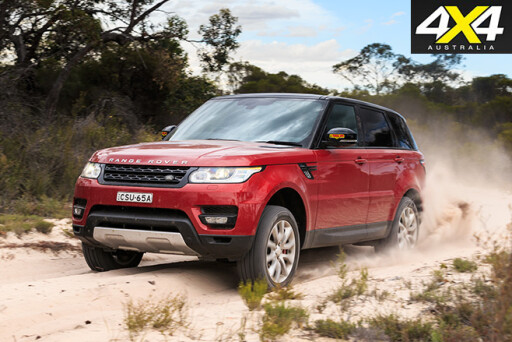 Few people have $150K to spend on a new 4x4, but if you do, there’s only one choice.
Few people have $150K to spend on a new 4x4, but if you do, there’s only one choice.
THERE are no surprises that a Range Rover of some description has made the Dirty Dozen list. The question is: which Range Rover? For our money it’s the Range Rover Sport SDV8, which is not only the pick of the vast Range Rover/Range Rover Sport line-up, but it’s better than any 4x4 or SUV from Audi, Bentley, BMW, Mercedes-Benz, Lexus or Porsche. The RRS SDV8 was our 4X4OTY two years back, so it joins the other 4X4OTY winners on this list.
For those who don’t know their Range Rovers, the SDV8 designation means it has the 4.4-litre bi-turbo-diesel V8, one of a vast array of engines available in the RRS or indeed the RR itself.
The distinction between the Range Rover and the Range Rover Sport is important here, too. In effect there’s little mechanical difference between the two as they share platforms and most of the multiple powertrain options. The key difference is in the body. The Range Rover’s is longer, taller and wider than the sleeker and, for most, more handsome body of the Sport.
That this second-generation RRS can claim to be a proper Range Rover sets it apart from the first-generation Range Rover Sport, which was built on a Discovery 3 platform.
Key to this generation of RRS (and RR) is the all-aluminium monocoque construction, which brings considerable weight savings over both the steel separate chassis of the first-generation RRS and the steel monocoque of the previous-gen RR.
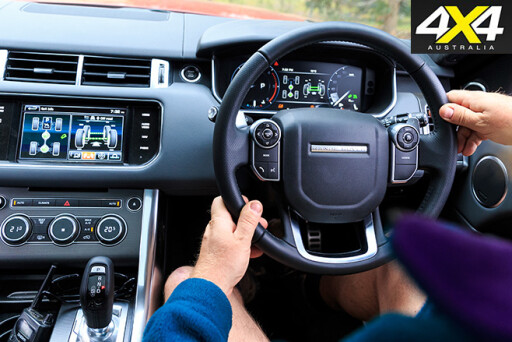 At 2400kg, the RRS Sport is still heavy but doesn’t feel it due to impeccable road manners and the effortless and ample power of the 250kW/740Nm diesel V8.
At 2400kg, the RRS Sport is still heavy but doesn’t feel it due to impeccable road manners and the effortless and ample power of the 250kW/740Nm diesel V8.
The SDV8 is one of three diesels on offer, the other two being 3.0-litre V6 diesels in different states of tune. There’s also a diesel-electric hybrid and four petrol engines, two supercharged V6s and two supercharged V8s, the most potent of which, the SRV, makes a mighty 405kW. That’s a truckload of fun, but it’s another $75K over the SDV8 – and it’s thirsty.
The SDV8 is the complete package. On-road it’s a luxury car with sports car performance and frugal economy, yet off-road it’s amazingly capable and will scramble up a gnarly hill with the best of them. The wheel/tyre spec isn’t the most practical, but at least in this generation of Range Rover and Range Rover Sport there’s been a move towards higher-profile tyres for any given wheel size, a welcome move in terms of off-road functionality.
SPECS
Price: $145,310
Engine: 4.4-litre V8 bi-turbo-diesel
Power: 250kW
Torque: 740Nm
Gearbox: eight-speed automatic
4x4 system: dual-range full-time
Front suspension: independent/air springs
Rear suspension: independent/air springs
Kerb weight: 2398kg
GVM: 3200kg
Towing capacity: 3500kg
Fuel tank capacity: 105 litres
ADR fuel claim: 8.7L/100km

COMMENTS